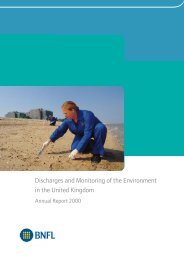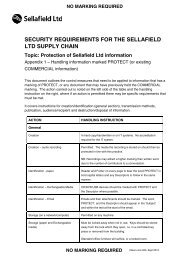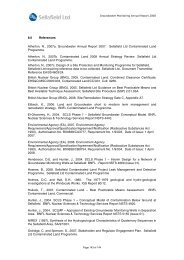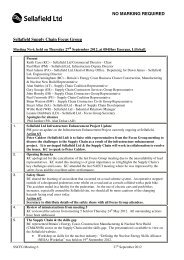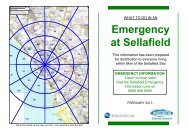Annual Report for 2010/11 and Forward Programme - Sellafield Ltd
Annual Report for 2010/11 and Forward Programme - Sellafield Ltd
Annual Report for 2010/11 and Forward Programme - Sellafield Ltd
Create successful ePaper yourself
Turn your PDF publications into a flip-book with our unique Google optimized e-Paper software.
SSEM/20<strong>11</strong>/4730 June 20<strong>11</strong>presence of 241 Am at 1E+04 Bq) in range of 1E+00 Bq to 1E+03 Bq. All otheradditional radionuclides detected above limit of detection are reported.iv) Measurement of beta gamma <strong>and</strong> gamma contact dose rates from separatedfinds using a Mini-Instruments SmartIon type ion chamber.v) Mass determination using Mettler AT balance capable of 2 microgram resolution.vi) Density determination by sequential fluid immersion in haloalkanes.vii) Shape determination using Alicona imaging.viii) Scanning electron microscopy imaging (SEM) (using non-coated technique <strong>and</strong>stub mounted on carbon mounting discs) on separated find <strong>and</strong> after bothstomach <strong>and</strong> gut leaching stages.ix) Energy dispersive X-ray analysis (EDX) on non-coated stub mounted separatedfind <strong>and</strong> after both stomach <strong>and</strong> gut leaching stages.x) Sequential leaching using simulated stomach solution, simulated gut solution, <strong>and</strong>total dissolution using mineral acids.xi) Solutions content determination of total beta, 60 Co, 90 Sr, 106 Ru, 125 Sn, 134 Cs, 137 Cs,152 Eu, 154 Eu, 155 Eu, 231 Th, 234 Th, 234 Pa, 238 Pu, 239 Pu, 240 Pu, 241 Pu, 242 Pu , 241 Am, 234 U,235 U, 236 U, <strong>and</strong> 238 U. Actinide analysis by alpha spectrometry <strong>and</strong> inductivelycoupled plasma mass spectrometry (ICP-MS), subcontracted to AMEC'sanalytical laboratory NIRAS. Metals analysis by inductively coupled plasmaoptical emission spectrometry (ICP-OES), subcontracted to the Scientific AnalysisLaboratory (SAL).xii) Solid content determination of total beta, 60 Co, 106 Ru, 125 Sn, 134 Cs, 137 Cs, 152 Eu,154 Eu, 155 Eu, 231 Th, 234 Th, 234 Pa, 238 Pu, 239 Pu, 240 Pu, 241 Pu, 242 Pu , 241 Am, 234 U, 235 U,236 U, <strong>and</strong> 238 U.The first Serco report was issued in December 2009 (Cowper ., 2009) <strong>and</strong> the second inJuly <strong>2010</strong> (Clacher ., <strong>2010</strong>). The third report is due to be published in September 20<strong>11</strong>In October 2008 a Geographic In<strong>for</strong>mation System (GIS) was developed with Jacobs toh<strong>and</strong>le beach monitoring data <strong>and</strong> give a visual interpretation that could be more easilyunderstood. The data processed by this system, <strong>and</strong> its graphical outputs, have been usedthroughout this report. The GIS support contract has been renewed since the initial setting upof the GIS with the focus mainly on consolidating the facilities provided <strong>and</strong> exp<strong>and</strong>ing theiruse. GIS development is ongoing to add tools to help identify beach find repopulation, tocreate a web-based GIS <strong>for</strong> wider dissemination of in<strong>for</strong>mation <strong>and</strong> to exp<strong>and</strong> on thestatistical analysis of spatial factors.Work has continued in 20<strong>11</strong>/12 on the statistical interpretation of the data through a contractstarted in August <strong>2010</strong> with the Department of Environmental Statistics at GlasgowUniversity. Contract deliverables include advice of how best to analyse the existing beachmonitoring data using statistical techniques (Scott <strong>and</strong> Tyler, 20<strong>11</strong>a) <strong>and</strong> what beachmonitoring programme will maximises the potential <strong>for</strong> meaningful statistical analysis (Scott<strong>and</strong> Tyler, 2001b).3.2.2 What has been achieved with this analytical data?Finds are grouped into particles <strong>and</strong> stones using the geological classification of coarse s<strong>and</strong>(i.e. International diameter of 0.2 to 2 mm) <strong>and</strong> gravel/stones (i.e. International diameter of >2 mm). A particle is there<strong>for</strong>e defined as being less than or equal to 2 mm in diameter <strong>and</strong> astone as being greater than 2 mm in diameter. It is recognised that not all finds are spherical<strong>and</strong> a visual inspection of the find is made during recovery. In most cases the particle orstone judgement is unambiguous with just <strong>11</strong>% of stone finds with size estimates less than 3mm.© Nuclear Decommissioning Authority 20<strong>11</strong>. 34



